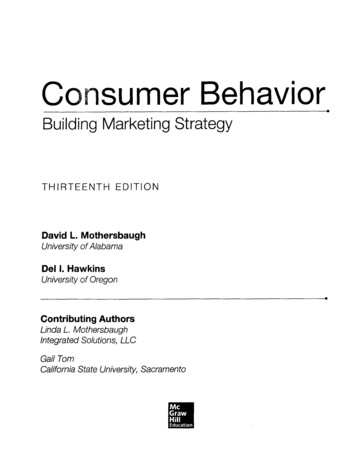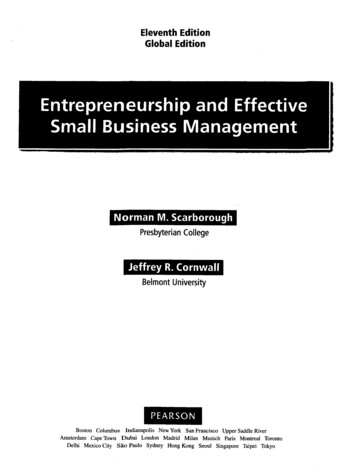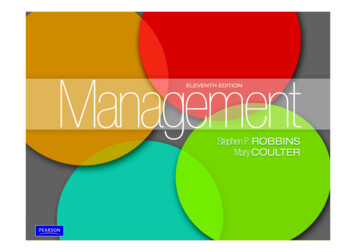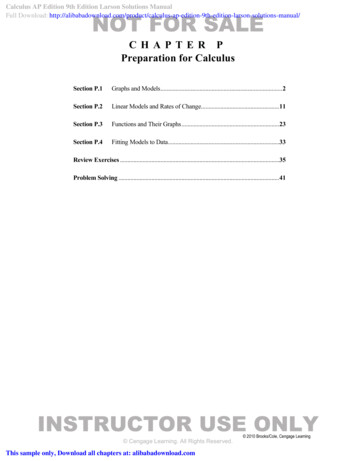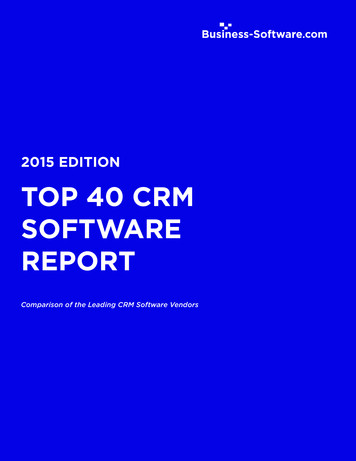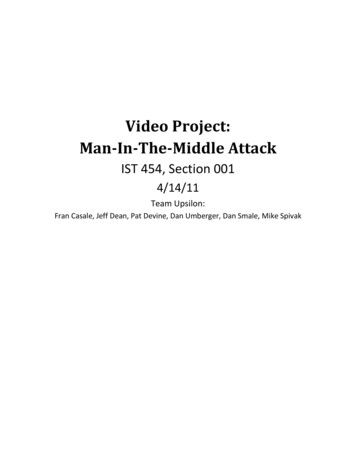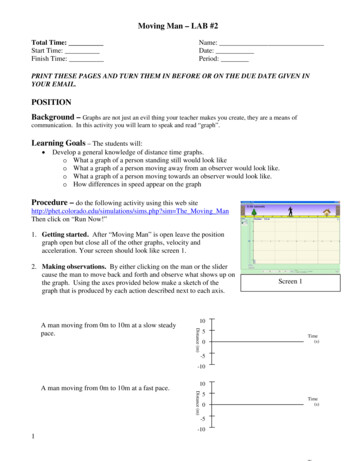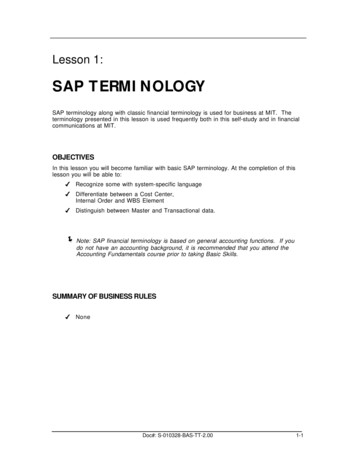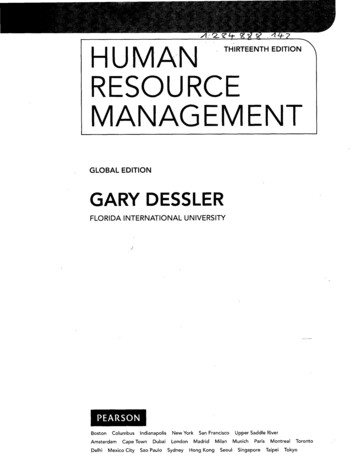
Transcription
-V-?THIRTEENTH EDITIONH U MANRESOURCEMANAGEMENTGLOBAL EDITIONGARY DESSLERFLORIDA INTERNATIONAL napolisCape TownMexico CityDubaiSao PauloNew YorkLondonSydneySan FranciscoMadridHong KongMilanSeoulUpper Saddle o
G O N T E N TSPreface 23AcknowledgmentsPART ONE1INTRODUCTION2728Introduction to Human Resource Management28WHAT IS HUMAN RESOURCE MANAGEMENT AND WHY IS IT IMPORTANT?What Is Human Resource Management? 30Why Is Human Resource Management Important to All Managers?Line and Staff Aspects of Human Resource Management 32Line Managers' Human Resource Duties 33Human Resource Manager's Duties 33New Approaches to Organizing HR 35Cooperative Line and Staff HR Management: An Example35THE TRENDS SHAPING HUMAN RESOURCE MANAGEMENTGlobalization and Competition Trends 37Indebtedness ("Leverage") and DeregulationTechnological Trends 38Trends in the Nature of Work 39313638 HR AS A PROFIT CENTER: Boosting Customer Service40Workforce and Demographic Trends 40Economic Challenges and Trends 42THE NEW HUMAN RESOURCE MANAGERS43Human Resource Management Yesterday and Today 43They Focus More on Strategic, Big Picture Issues 43 THE STRATEGIC CONTEXT: Building LL.Bean43They Use New Ways to Provide Transactional Services44They Take an Integrated, "Talent Management" Approach to ManagingHuman Resources 45They Manage Ethics 45They Manage Employee Engagement 45They Measure HR Performance and Results 45They Use Evidence-Based Human Resource ManagementThey Add Value 46They Have New Competencies 47HR Certification 48THE PLAN OF THIS BOOK4648The Basic Themes and FeaturesCHAPTER CONTENTS OVERVIEW4849Part 1: Introduction 49Part 2: Recruitment, Placement, and Talent ManagementPart 3: Training and Development 49Part 4: Compensation 49Part 5: Employee Relations 49The Topics Are Interrelated 50CHAPTER SECTION SUMMARIES 51DISCUSSION QUESTIONS 51INDIVIDUAL AND GROUP ACTIVITIES 52EXPERIENTIAL EXERCISE: HELPING "THE DONALD" 52APPLICATION CASE: JACK NELSON'S PROBLEM 53CONTINUING CASE: CARTER CLEANING COMPANY 53KEY TERMS 54ENDNOTES 544930
8CONTENTS2Equal Opportunity and the Law 56EQUAL EMPLOYMENT OPPORTUNITY 1964-1991Title VII of the 1964 Civil Rights Act 5858Executive Orders 58Equal Pay Act of 1963 59Age Discrimination in Employment Act of 1967 59Vocational Rehabilitation Act of 1973 59Pregnancy Discrimination Act of 1978 60Federal Agency Guidelines 60Early Court Decisions Regarding Equal Employment Opportunity 60EQUAL EMPLOYMENT OPPORTUNITY 1990-91-PRESENT 61The Civil Rights Act of 1991 61The Americans with Disabilities Act 62Genetic Information Nondiscrimination Act of 2008 (GINA) 65State and Local Equal Employment Opportunity Laws 65Sexual Harassment 65DEFENSES AGAINST DISCRIMINATION ALLEGATIONS 69The Central Role of Adverse Impact 70Bona Fide Occupational Qualification 72Business Necessity 73Other Considerations in Discriminatory Practice Defenses 74ILLUSTRATIVE DISCRIMINATORY EMPLOYMENT PRACTICES 74A Note on What You Can and Cannot Do 74Recruitment 75Selection Standards 75Sample Discriminatory Promotion, Transfer, and Layoff Practices 76What the Supervisor Should Keep in Mind 77THE EEOC ENFORCEMENT PROCESS 77Voluntary Mediation 79Mandatory Arbitration of Discrimination Claims 80DIVERSITY MANAGEMENT AND AFFIRMATIVE ACTION PROGRAMSDiversity's Potential Pros and Cons 81 HR AS A PROFIT CENTER8182Managing Diversity 82Encouraging Inclusiveness 83Developing a Multicultural Consciousness 84Equal Employment Opportunity Versus Affirmative Action 85Implementing the Affirmative Action Program 85Reverse Discrimination 86CHAPTER SECTION SUMMARIES 87DISCUSSION QUESTIONS 88INDIVIDUAL AND GROUP ACTIVITIES 88EXPERIENTIAL EXERCISE: "SPACE CADET" OR VICTIM? 89APPLICATION CASE: THE EMIRATISATION HRM PRACTICES OF A PETROLEUM COMPANYCONTINUING CASE: CARTER CLEANING COMPANY 90KEY TERMS 91ENDNOTES 91Human Resource Management Strategy and AnalysisTHE STRATEGIC MANAGEMENT PROCESS9698 THE STRATEGIC CONTEXT: The Shanghai Portman HotelGoal-Setting and the Planning Process899898Strategic Planning 99Improving Productivity Through HRIS: Using Computerized Business Planning SoftwareTypes of Strategies 102Top Managers' Role in Strategic Planning 104102
CONTENTS9Departmental Managers' Strategic Planning Roles 104Departmental Managers' Strategic Planning Roles in Action: Improving Mergers andAcquisitions 105STRATEGIC H U M A N RESOURCE M A N A G E M E N T106Defining Strategic Human Resource Management 106Human Resource Strategies and Policies 108 HR AS A PROFIT CENTER: Albertsons ExampleStrategic Human Resource Management ToolsHR METRICS AND BENCHMARKING108108110Types of Metrics 111Improving Productivity Through HRIS: Tracking Applicant Metrics for Improved TalentManagement 111Benchmarking in Action 112Strategy and Strategy-Based Metrics 113Workforce/Talent Analytics and Data Mining 113 HR AS A PROFIT CENTER: Using Workforce/Talent Analytics114What Are HR Audits? 115Evidence-Based HR and the Scientific Way of Doing Things 116WHAT ARE HIGH-PERFORMANCE WORK SYSTEMS?117High-Performance Human Resource Policies and Practices 118CHAPTER SECTION SUMMARIES 119DISCUSSION QUESTIONS 120INDIVIDUAL AND GROUP ACTIVITIES 120EXPERIENTIAL EXERCISE: DEVELOPING AN HR STRATEGY FOR STARBUCKS 121APPLICATION CASE: SIEMENS BUILDS A STRATEGY-ORIENTED HR SYSTEM 121CONTINUING CASE: CARTER CLEANING COMPANY 122TRANSLATING STRATEGY INTO HR POLICIES & PRACTICES CASE: THE HOTEL PARIS CASEKEY TERMS 124ENDNOTES 125PART 1 VIDEO CASES APPENDIX 126PART TWO4RECRUITMENT, PLACEMENT, AND TALENTMANAGEMENT 128Job Analysis and the Talent Management ProcessTHE TALENT M A N A G E M E N T PROCESSWhat Is Talent Management? 130THE BASICS OF JOB ANALYSIS131Uses of Job Analysis Information 132130 T H E STRATEGIC C O N T E X T : Daimler Alabama ExampleConducting a Job Analysis133133 HR AS A PROFIT CENTER: Boosting Productivity through Work RedesignJob Analysis Guidelines 136METHODS FOR COLLECTING JOB ANALYSIS INFORMATIONThe Interview 136Questionnaires 139Observation 140Participant Diary/Logs 140Quantitative Job Analysis Techniques 140Internet-Based Job Analysis 142WRITING JOB DESCRIPTIONSJob Identification 144Job Summary 145Relationships 147Responsibilities and Duties128144147136134122
10CONTENTSD MANAGING THE NEW WORKFORCE: Writing Job Descriptions That Complywith the ADA 148Standards of Performance and Working ConditionsDuty: Accurately Posting Accounts Payable 148148Using the Internet for Writing Job Descriptions 148WRITING JOB SPECIFICATIONS152Specifications for Trained Versus Untrained Personnel 152Specifications Based on Judgment 152Job Specifications Based on Statistical Analysis 153Using Task Statements 153PROFILES IN TALENT MANAGEMENT154Competencies and Competency-Based Job Analysis 154How to Write Job Competencies-Based Job DescriptionsCHAPTER SECTION SUMMARIES 157DISCUSSION QUESTIONS 158INDIVIDUAL AND GROUP ACTIVITIES 158156EXPERIENTIAL EXERCISE: THE INSTRUCTOR'S JOB DESCRIPTION 158APPLICATION CASE: RECRUITING IN EUROPE 159CONTINUING CASE: CARTER CLEANING COMPANY 159TRANSLATING STRATEGY INTO HR POLICIES & PRACTICES CASE: THE HOTELPARIS CASE 160KEY TERMS 160ENDNOTES 160Personnel Planning and RecruitingINTRODUCTION164WORKFORCE PLANNING AND FORECASTINGStrategy and Workforce Planning 164 THE STRATEGIC CONTEXT: KPMG 165162164Forecasting Personnel Needs (Labor Demand) 165Improving Productivity Through HRIS: Computerized Personnel ForecastingForecasting the Supply of Inside Candidates 168168Forecasting the Supply of Outside Candidates 170Talent Management and Predictive Workforce Monitoring 170Developing an Action Plan to Match Projected Labor Supply and Labor DemandThe Recruiting Yield Pyramid 171THE NEED FOR EFFECTIVE RECRUITING 172Why Recruiting Is Important 172What Makes Recruiting a Challenge? 172Organizing How You Recruit 172INTERNAL SOURCES OF CANDIDATES173Using Internal Sources: Pros and Cons 173Finding Internal Candidates 173Rehiring 173Succession Planning 174Improving Productivity Through HRIS: Succession and Talent Planning SystemsOUTSIDE SOURCES OF CANDIDATES 175Recruiting via the Internet 175Advertising 178Employment Agencies 180Temp Agencies and Alternative Staffing 181Offshoring and Outsourcing Jobs 183Executive Recruiters 183On-Demand Recruiting Services 184College Recruiting 184Referrals and Walk-Ins 185Telecommuters 186Military Personnel 186171174
CONTENTSRecruiting Source Use and Effectiveness 186Evidence-Based HR: Measuring Recruiting Effectiveness187 HR AS A PROFIT CENTER: Personnel Planning and Recruiting188Improving Productivity Through HRIS: An Integrated Approach to RecruitingRECRUITING A MORE DIVERSE WORKFORCE188Single Parents 188Older Workers 189Recruiting Minorities 189Welfare-to-Work 190The Disabled 190DEVELOPING AND USING APPLICATION FORMS190Purpose of Application Forms 190Application Guidelines 192Application Forms and EEO Law 192Using Application Forms to Predict Job Performance 193Mandatory Arbitration 193CHAPTER SECTION SUMMARIES 193DISCUSSION QUESTIONS 194INDIVIDUAL AND GROUP ACTIVITIES 194EXPERIENTIAL EXERCISE: THE NURSING SHORTAGE 195APPLICATION CASE: YA KUN KAYA TOAST 195CONTINUING CASE: CARTER CLEANING COMPANY 196TRANSLATING STRATEGY INTO HR POLICIES & PRACTICES CASE: THE HOTELPARIS CASE 196KEY TERMS 197ENDNOTES 1976Employee Testing and Selection200WHY CAREFUL SELECTION IS IMPORTANT202Person and Job/Organization Fit202 THE STRATEGIC CONTEXT: Crowd Sourcing at GoogleBASIC TESTING CONCEPTS202203Reliability 203Validity 204Evidence-Based HR: How to Validate a TestBias 208Utility Analysis 208206 HR AS A PROFIT CENTER: Reducing Turnover at Key BankValidity Generalization 209Test Takers' Individual Rights and Test SecurityHow Do Employers Use Tests at Work? 210Computerized and Online TestingTYPES OF TESTS209211212Tests of Cognitive Abilities 212Tests of Motor and Physical AbilitiesMeasuring Personality and InterestsAchievement Tests 216WORK SAMPLES AND SIMULATIONS213213216Using Work Sampling for Employee Selection 216Situational Judgment Tests 217Management Assessment Centers 217Situational Testing and Video-Based Situational Testing218Computerized Multimedia Candidate Assessment Tools 218The Miniature Job Training and Evaluation Approach 219Realistic Job Previews 219HR in Practice: Testing Techniques for Managers 219Summary 22020918811
12CONTENTSBACKGROUND INVESTIGATIONS AND OTHER SELECTION METHODSWhy Perform Background Investigations and Reference Checks?The Legal Dangers and How to Avoid Them 221220220How to Check a Candidate's Background 222The Social Network: Checking Applicants' Social Postings 224Using Preemployment Information Services 225The Polygraph and Honesty Testing 225Graphology 227"Human Lie Detectors" 227Physical Exams 227Substance Abuse Screening 228Complying with Immigration Law 229Improving Productivity Through HRIS: Using Automated Applicant Tracking and ScreeningSystems 230CHAPTER SECTION SUMMARIES 230DISCUSSION QUESTIONS 231INDIVIDUAL AND GROUP ACTIVITIES 231EXPERIENTIAL EXERCISE: A TEST FOR A RESERVATION CLERK 232APPLICATION CASE: KPMG 232CONTINUING CASE: HONESTY TESTING AT CARTER CLEANING COMPANY 233TRANSLATING STRATEGY INTO HR POLICIES & PRACTICES CASE: THE HOTEL PARIS CASEKEY TERMS 234ENDNOTES 2347Interviewing Candidates233238BASIC TYPES OF INTERVIEWS 240 THE STRATEGIC CONTEXT: Whirlpool Corp.240Structured Versus Unstructured Interviews 240Interview Content (What Types of Questions to Ask)How Should We Administer the Interview? 244 HR AS A PROFIT CENTER: Great Western BankThree Ways to Make the Interview Usefulness241246247THE ERRORS THAT UNDERMINE AN INTERVIEW'S USEFULNESSFirst Impressions (Snap Judgments) 248Not Clarifying What the Job Requires 248Candidate-Order (Contrast) Error and Pressure to Hire 248Nonverbal Behavior and Impression Management 249Effect of Personal Characteristics: Attractiveness, Gender, Race247249 MANAGING THE NEW WORKFORCE: Applicant Disability and the EmploymentInterview 250Interviewer Behavior 250HOW TO DESIGN AND CONDUCT AN EFFECTIVE INTERVIEW251Designing a Structured Situational Interview 251How to Conduct an Effective Interview 252Talent Management: Profiles and Employee Interviews 255CHAPTER SECTION SUMMARIES 255DISCUSSION QUESTIONS 256INDIVIDUAL AND GROUP ACTIVITIES 256EXPERIENTIAL EXERCISE: THE MOST IMPORTANT PERSON YOU'LL EVER HIRE 257APPLICATION CASE: NURSE RECRUITMENT AT GULF HOSPITAL 257CONTINUING CASE: CARTER CLEANING COMPANY 258TRANSLATING STRATEGY INTO HR POLICIES & PRACTICES CASE: THE HOTEL PARIS CASEKEY TERMS 259ENDNOTES 259APPENDIX 1 FOR CHAPTER 7 APPLICANT INTERVIEW GUIDE 262APPENDIX 2 FOR CHAPTER 7 INTERVIEW GUIDE FOR INTERVIEWEES 264PART 2 VIDEO CASES APPENDIX 266258
CONTENTSPART THREE8TRAINING AND DEVELOPMENT268Training and Developing Employees268ORIENTING AND ONBOARDING NEW EMPLOYEES 270The Purposes of Employee Orientation/Onboarding 270The Orientation Process 270OVERVIEW OF THE TRAINING PROCESS 272Aligning Strategy and Training 272 THE STRATEGIC CONTEXT: CapitaLandTraining and Performance272273The ADDIE Five-Step Training Process 273Conducting the Training Needs Analysis 273Designing the Training Program 276Developing the Program 279IMPLEMENTING TRAINING PROGRAMS 279On-the-Job Training 279Apprenticeship Training 281Informal Learning 281Job Instruction Training 281Lectures 282Programmed Learning 282Audiovisual-Based Training 283Vestibule Training 283Electronic Performance Support Systems (EPSS) 283Videoconferencing 284Computer-Based Training (CBT) 284Simulated Learning 284Interactive Learning 285Internet-Based Training 285Improving Productivity Through HRIS: Learning Management SystemsMobile Learning 286The Virtual Classroom 287286Lifelong and Literacy Training Techniques 287 MANAGING THE NEW WORKFORCE: Diversity Training288Team Training 288IMPLEMENTING MANAGEMENT DEVELOPMENT PROGRAMS 289Strategy and Development 289Managerial On-the-Job Training 289Off-the-Job Management Training and Development
CONTINUING CASE: CARTER CLEANING COMPANY 53 KEY TERMS 54 ENDNOTES 54 30. 8 CONTENTS 2 Equal Opportunity and the Law 56 EQUAL EMPLOYMENT OPPORTUNITY 1964-1991 58 Title VII of the 1964 Civil Rights Act 58 Executive Orders 58 Equal Pay Act of 1963 59 Age Discrimination in Employment Act of 1967 59 Vocational Rehabilitation Act of 1973 59 Pregnancy Discrimination Act
